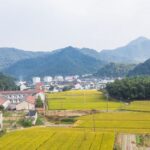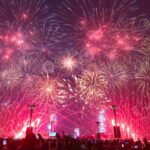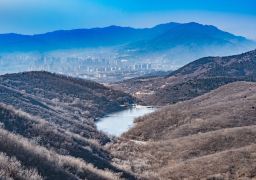Chu Yang Valley features three connected stone caves that are exquisitely transparent and round like rice sieves, also known as ‘Three Orifices of Yang Valley’. Every morning when the sun rises, a miraculous beam of sunlight penetrates through all three caves. Entering from ‘Half Wall Pond’, one ascends along the winding paths and stone steps. The main cave is tall and spacious with a dome-like ceiling, and the ground is flat.
In front of the cave, there is a giant rock resembling a screen, making the stone chamber extremely quiet and elegant. There is a bowl-sized hole in the cave’s ceiling, rumored to be the place where ancient people hung their lamps for night reading. The cave retains numerous cliff inscriptions left by literati and calligraphers since the Tang Dynasty, with various styles including running, regular, clerical, and seal scripts, all displayed in abundance. A precious inscription is the ‘Ni Weng Cave’ in small seal script by Li Yangbing, a calligrapher of the Tang Dynasty who once served as the county magistrate of Jinyun. It is said that an official with the surname Ni, who despised the worldly customs, secluded himself here but left no name. When Li Yangbing served as the county magistrate of Boyun, he referred to the hermit as ‘Ni Weng’ and inscribed ‘Ni Weng Cave’ in three characters in the year 759 AD, carving it on the mouth of the cave atop a huge rock. Later generations built the ‘Ping Xu Pavilion’ to protect the calligraphy, and to this day, the stone carving remains undamaged, with clear characters. Ming Dynasty Minister of Justice Qiao Zhi (styled as Xu Shan) and Censor Fan Xian Ke (styled as Dou Shan) also once secluded themselves in the ‘Two Valley Caves’, hence the stone walls bear inscriptions such as ‘Xu Shan’ and ‘Dou Shan Dong Tian’. In April 1980, the Jinyun County Committee listed the ‘Ni Weng Cave’ and the cliff inscriptions in the Xiandu Scenic Area as historical artifacts for enhanced protection. Other attractions at the Ni Weng Cave site include ‘Mouse Stealing Oil’, ‘Dufeng Academy’, ‘Wen Yu Pavilion’, ‘Uncle’s Sedan Rock’, and ‘Moon Mirror Rock’. Moon Mirror Rock: Between Dongmeng Rock and Wulao Peak, there is a cluster of rocks resembling a group of fairies, facing the ‘Moon Mirror’ on Hao Mountain as they dress up, hence the name ‘Fairy Mirroring’. It is said that in ancient times, a group of fairies, feeling lonely in heaven, wanted to visit the mortal world. They dressed up in front of the mirror on the platform of jade, then sang and danced, with their melodious music reaching the human world. In the north, in the Turtle Cave, there was a monk practicing, who, upon hearing the pleasant fairy music, secretly went to the Immortal Reef to peep and saw the fairies dancing happily, staring blankly and becoming entranced. In this way, he turned into a fossil. The entire text is open from 4/29 to 10/31 (high season) from 07:30 to 17:30; from 11/1 to 4/28 (low season) from 08:00 to 17:00.Ni Weng Cave
Chu Yang Valley features three connected stone caves that are exquisitely transparent and round like[...]









